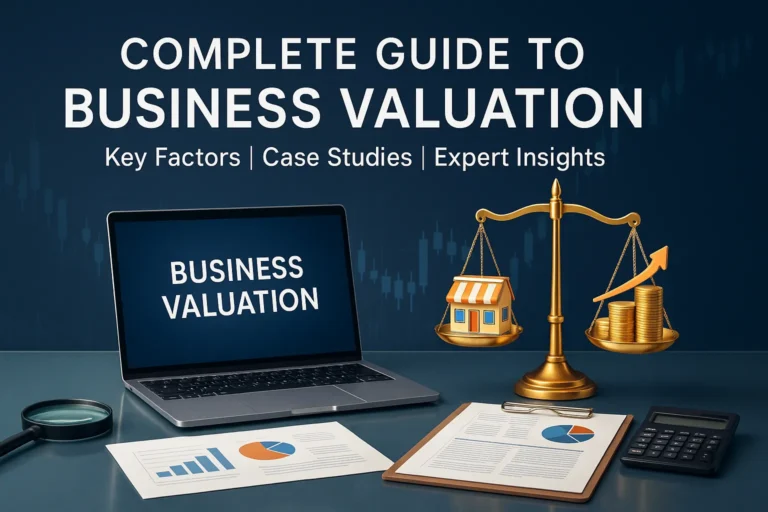Ultimate Guide to Measuring Your Business Financial Health: Key Metrics Unveiled
Why Measuring Your Business Financial Health Matters
Running a business isn’t just about making sales or chasing revenue. To truly succeed, you need a clear picture of your company’s financial health. How do you know if your business is thriving or just surviving? By tracking key financial and operational metrics, you can uncover strengths, spot weaknesses, and make data-driven decisions for sustainable growth. Metrics like cash flow, gross profit margin, net profit margin, customer acquisition cost, and retention rates offer insights beyond simple revenue figures. In this ultimate guide, we’ll explore the essential metrics to measure your business’s financial health, explain how to use them, and share real-world examples to help you steer your company toward profitability and long-term success. Ready to dive in? Let’s get started!
What Is Business Financial Health?
Financial health refers to your company’s ability to generate revenue, manage expenses, pay debts, and grow sustainably. It’s like a checkup for your business—assessing liquidity, solvency, profitability, and efficiency. Without this insight, you’re guessing, which can lead to overspending, missed opportunities, or even failure. By monitoring the right metrics, you:
- Detect problems early (e.g., cash shortages)
- Optimize pricing and costs
- Plan for expansion with confidence
- Attract investors or lenders with solid data
Let’s break down the critical areas and the top metrics to track for a healthy business.
Key Areas of Financial Health
Liquidity: Can You Cover Short-Term Needs?
Liquidity measures how easily your business can pay short-term obligations like bills, payroll, and suppliers with cash or assets that convert quickly to cash. Without liquidity, even profitable businesses can falter. Here are the top metrics to watch:
Current Ratio
- What It Is: Current assets divided by current liabilities
- Formula: Current Ratio = Current Assets / Current Liabilities
- Why It Matters: Shows if you can cover short-term debts. A ratio above 1 is ideal; below 1 signals trouble.
- Example: If your business has $100,000 in assets (cash, inventory, etc.) and $80,000 in liabilities (payables, loans), your current ratio is 1.25—a healthy sign.
Quick Ratio (Acid Test)
- What It Is: A stricter measure, excluding inventory from assets
- Formula: Quick Ratio = (Current Assets – Inventory) / Current Liabilities
- Why It Matters: Inventory sells slowly, so this tests your ability to pay debts fast. A ratio below 1.0 is a red flag.
- Real-World Use Case: A retail store with $50,000 in cash, $20,000 in receivables, $30,000 in inventory, and $60,000 in liabilities has a quick ratio of (50,000 + 20,000) / 60,000 = 1.17. It’s just above 1, but cutting inventory costs could strengthen it.
Solvency: Are You Built for the Long Haul?

Solvency assesses your ability to meet long-term debt obligations, reflecting stability and investor confidence. A solvent business can thrive for years.
Debt-to-Equity Ratio (D/E)
- What It Is: Total debt divided by shareholders’ equity
- Formula: D/E Ratio = Total Debt / Shareholders’ Equity
- Why It Matters: A lower ratio (e.g., below 1) means more funding comes from owners than creditors, a positive sign. Ratios vary by industry.
- Trend Tip: A downward D/E trend over time shows improving financial ground.
- Example: A tech startup with $200,000 in debt and $300,000 in equity has a D/E ratio of 0.67—solid for growth.
Operating Efficiency: How Well Do You Run?
Efficiency measures how effectively you turn inputs (costs, labor) into outputs (revenue, products). Good management drives efficiency.
Operating Margin
- What It Is: Operating profit divided by revenue
- Formula: Operating Margin = (Revenue – Operating Costs) / Revenue x 100
- Why It Matters: Shows cost control after variable costs (e.g., production, marketing). Higher margins mean better efficiency.
- Use Case: A bakery with $500,000 in revenue and $400,000 in operating costs (ingredients, labor) has a 20% operating margin—room to reinvest or cut costs.
Profitability: The Ultimate Health Indicator
Profitability is king. It’s your ability to turn revenue into profit after all costs. A business can survive temporarily without profits, but long-term success demands it.
Gross Profit Margin
- What It Is: Revenue minus cost of goods sold (COGS), divided by revenue
- Formula: Gross Profit Margin = (Revenue – COGS) / Revenue x 100
- Why It Matters: Reflects pricing and production efficiency. A high margin (e.g., above 30%) leaves cash for growth.
- Stat: Industries vary—retail often sees 20-30%, while software can hit 70-80%.
- Example: A clothing brand with $1M in sales and $600,000 in COGS (materials, labor) has a 40% gross margin—healthy for retail.
Net Profit Margin
- What It Is: Net profit divided by revenue
- Formula: Net Profit Margin = (Revenue – All Expenses) / Revenue x 100
- Why It Matters: The best single indicator of financial health, showing profit after all costs (taxes, overhead, etc.). Above 10% is often strong.
- Use Case: A consultancy with $2M in revenue and $1.7M in total expenses (salaries, rent, taxes) has a 15% net margin—solid for expansion.
Customer-Centric Metrics: Beyond the Balance Sheet
Financials alone don’t tell the whole story. Customer metrics reveal growth potential and stability.
Customer Acquisition Cost (CAC)
- What It Is: Total cost to gain a new customer (marketing, sales, etc.)
- Formula: CAC = Total Sales & Marketing Costs / New Customers Acquired
- Why It Matters: A low CAC relative to customer value signals efficient growth. High CAC can drain profits.
- Example: A SaaS firm spends $50,000 on ads and sales to gain 500 customers. CAC = $100—affordable if customers bring high value.
Customer Retention Rate
- What It Is: Percentage of customers who return over time
- Formula: Retention Rate = [(Customers at End – New Customers) / Customers at Start] x 100
- Why It Matters: Retaining customers is cheaper than acquiring new ones. Strong retention means happy clients and steady revenue.
- Stat: Acquiring a new customer can cost 5-7 times more than retaining one.
- Use Case: A gym starts with 1,000 members, gains 200, and ends with 950. Retention = [(950 – 200) / 1,000] x 100 = 75%—decent, but churn needs attention.
Customer Lifetime Value (CLV)
- What It Is: Total revenue expected from a customer over their relationship
- Formula: CLV = Average Sale per Visit x Visits per Customer x Customer Lifespan
- Why It Matters: High CLV justifies spending on retention and acquisition. Aim for CLV to be 3x CAC or more.
- Example: A coffee shop’s average customer spends $5 per visit, visits 50 times a year, and stays for 3 years. CLV = $5 x 50 x 3 = $750—valuable!
How to Track These Metrics

- Use Accounting Software: Tools like QuickBooks or Xero calculate cash flow, margins, and ratios automatically.
- CRM Systems: HubSpot or Salesforce track CAC, retention, and CLV.
- Regular Reviews: Check monthly or quarterly to spot trends.
- Year-Over-Year Data: Compare annual figures for a big-picture view (e.g., a 100% revenue increase despite a 30% monthly drop isn’t alarming).
- Benchmarking: Compare to industry standards—e.g., a 10% net margin is great for retail but low for tech.
Real-Life Examples of Metrics in Action
- Retail Store Turnaround: A boutique had a low gross profit margin (15%) due to high COGS. By negotiating better supplier deals, they boosted it to 25%, freeing cash for marketing.
- Tech Startup Growth: A SaaS company tracked CAC ($200) and CLV ($1,000). With a 5:1 ratio, they doubled ad spend, gaining customers and scaling fast.
- Service Business Stability: A plumbing firm noticed negative cash flow despite profits. By speeding up invoice collection, they turned cash flow positive, avoiding debt.
Tips to Improve Your Business’s Financial Health
- Boost Liquidity: Keep a cash reserve, speed up receivables, delay non-essential payments.
- Reduce Debt: Pay down high-interest loans to lower your D/E ratio.
- Cut Costs: Audit production and operating expenses for savings.
- Increase Margins: Raise prices strategically or streamline processes.
- Retain Customers: Offer loyalty programs, excellent service, and regular feedback surveys.
- Monitor Regularly: Use dashboards for real-time insights.
FAQs About Business Financial Health
Conclusion: Take Control of Your Business’s Financial Health
Measuring your business’s financial health isn’t a one-time task—it’s an ongoing process to ensure profitability, stability, and growth. By tracking key metrics like cash flow, gross and net profit margins, customer acquisition cost, retention rate, and customer lifetime value, you gain the insights needed to make smart decisions. Pair these with liquidity and solvency ratios for a complete view. Don’t rely on gut feelings—use data to spot issues, optimize operations, and seize opportunities. Ready to take control? Start by auditing your metrics today, leverage tools like QuickBooks or a CRM, and watch your business thrive. What’s your next step? Review one metric this week and build a plan to improve it—your future success depends on it!






